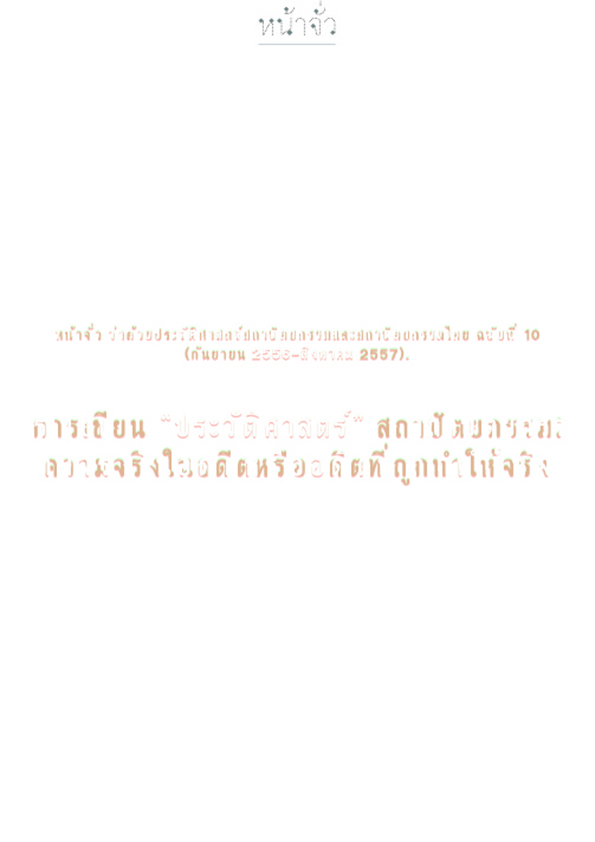“เขาพระสุเมรุ” กับ อาคารรัฐสภาใหม่ไทย: “สภาวะแห่งการยกเว้น” ในฐานะกระบวนทัศน์การสร้างงานสถาปัตยกรรม ‘Mount Sumeru’ and the New Thai Parliament House : The ‘State of Exception’ as a Paradigm of Architectural Practices
Main Article Content
Abstract
บทคัดย่อ
ช่วงระหว่าง พ.ศ. 2548 ถึง พ.ศ. 2553 ประเทศไทยตกอยู่ในสถานการณ์ความไม่สงบทางการเมือง นับตั้งแต่การประท้วงบนท้องถนน การรัฐประหาร และความรุนแรงต่าง ๆ ในบริบทที่สังคมไทยมีความแตกแยกที่ร้าวลึกนี้อาคารรัฐสภาใหม่ “สัปปายะสภาสถาน” ได้สถาปนาตัวเองขึ้นเป็นสถาปัตยกรรมที่เป็นสัญลักษณ์ทางศีลธรรม โดยถูกสร้างขึ้นเป็น “เขาพระสุเมรุ” ซึ่งตามหลักจักรวาลวิทยาทางศาสนาฮินดูและพุทธคือ “ภูเขาศูนย์กลางแห่งจักรวาล” ความพยายามของโครงการซึ่งชนะการประกวดการออกแบบรัฐสภาแห่งชาตินี้ขัดแย้งกับความไม่เป็นเนื้อเดียวกันที่เพิ่มขึ้นของสังคมไทย ด้วยเหตุนี้บทความนี้มีเจตนาที่จะศึกษาไม่เพียงเฉพาะการยึดติดกับ “ความเป็นไทย (Thainess)” ผ่านการย้อนกลับมาของหลักประเพณีทางสถาปัตยกรรม แต่รวมถึงผลกระทบต่อความสัมพันธ์เชิงโครงสร้างระหว่างรัฐและพลเมือง(nation-citizen relationship) ในการวิเคราะห์ประเด็นเหล่านี้บทความเชื่อมโยงแนวคิด “สภาวะแห่งการยกเว้น (state of exception)” ของนักปรัชญาจิออร์จิโอ อกัมเบน (Giorgio Agamben) เข้ากับการสร้างงานสถาปัตยกรรมบนช่วงวิกฤติการของประเทศ ซึ่งเป็นสภาวะกำกวมที่ดูจะต้องการมาตรการพิเศษบางอย่างในการแก้ปัญหา ในกรณีนี้สัปปายะสภา-สถานดูเหมือนจะยืนอยู่บนความชอบธรรม แต่ขณะเดียวกันก็เป็นความชอบธรรมที่เป็นปัญหา ในรายละเอียด บทความวิเคราะห์รูปแบบของการยกเว้นที่แฝงอยู่ในกรอบความคิดของโครงการในประเด็นทางประวัติศาสตร์ (history) การแสดงความหมาย (signification) และความเป็นบุคคลของผู้ใช้งาน(subjectivity) บทความเสนอข้อสรุปว่าสัปปายะสภาสถานเป็น “สถาปัตยกรรมแห่งสภาวะการยกเว้น (architecture of state of exception)” ซึ่งไม่เพียงแขวนบทบาทของตัวเองในฐานะสถาปัตยกรรมแห่งประชาธิปไตยเอาไว้ แต่ยังมีนัยยะการพักความสัมพันธ์เชิงประชาธิปไตยระหว่างรัฐและพลเมืองอยู่ด้วย ที่สุดแล้วอาจกล่าวได้ว่าสัปปายะสภาสถานคือตัวอย่างของความรุนแรงเชิงสถาปัตยกรรมที่ถูกสร้างขึ้นภายใต้เจตนาที่จะกอบกู้ประเทศของสถาปนิกในประเด็นของการเขียนประวัติศาสตร์ทางสถาปัตยกรรม บทความนำเสนอให้เห็นถึงความเป็นไปได้และความสำคัญ ในการเชื่อมโยงสถาปัตยกรรมเข้ากับทฤษฏีจากสาขาวิชาอื่น ๆ ซึ่งในที่นี้ประกอบด้วยแนวคิดทางปรัชญาการเมือง การศึกษายุคหลังอาณานิคม สัญวิทยา และเพศสภาพศึกษา ทั้งนี้ก็เพื่อความเข้าใจที่ลึกซึ้งต่อวิชาชีพสถาปนิก และโครงการสถาปัตยกรรมที่สัมพันธ์อย่างแยกไม่ออกจากบริบททางสังคมและการเมือง
Abstract
Since 2005, Thailand has been entangled in a state of political unrest; from a military coup to street protests and violence, the nation is severely divided. Within this context, the new Thai parliament house is conceived as ‘Mount Sumeru’, a central ‘world-mountain’ according to the ancient Hindu-Buddhist cosmology – Tri-Bhumi. Aimed to be an architecture of symbolic morality for the nation in crisis, the competition’s winning proposal ‘Sappaya-Sapasathan’, however, neglects heterogeneous Thai society. Accordingly, this paper is intended not only as a discussion on the fixation with the notion of ‘Thainess’ through the return of a traditional architectural principle but also as a view towards the implications on the nation-citizen relationship. The paper binds the notion of the ‘state of exception’ of Giorgio Agamben with architectural practices. Due to the ambiguous necessity for an exceptional measure during a critical time for the nation, Sappaya-Sapasathan gains its legitimacy, yet remains problematic. By investigating forms of exclusions in the proposal’s conceptions of history, signification and subjectivity, the paper argues that Sappaya-Sapasathan is an architecture of a state of exception which does not only suspend its status as a democratic architecture but also it suspends the democratic relationship between the nation-state and its citizenry. Ultimately, this is an example of how the violence of architecture is materialised in the redemption of a nation.


